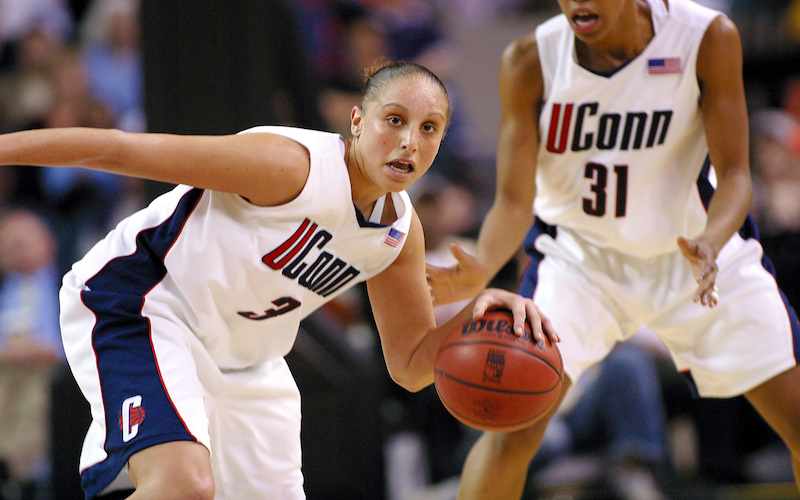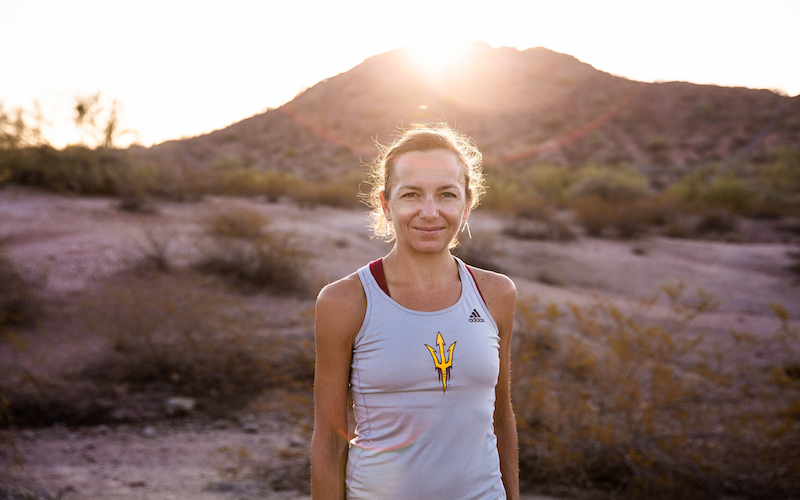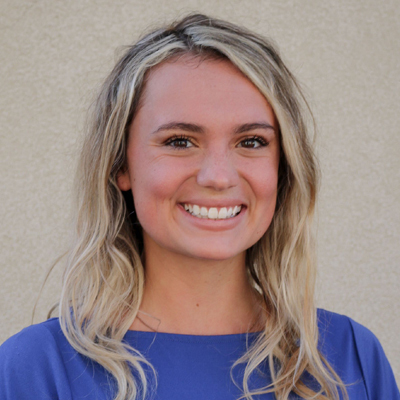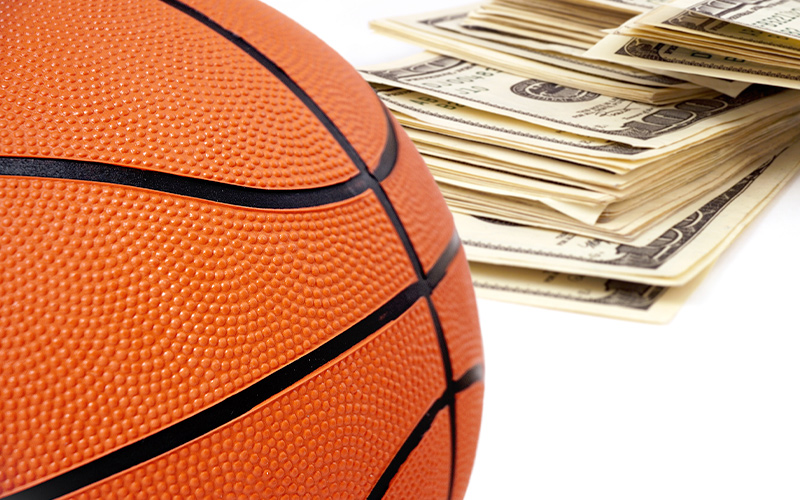
The Phoenix Mercury’s Diana Taurasi is not surprised about the uproar that highlighted the disparities of the men’s and women’s postseason basketball tournaments. She saw it when she played at Connecticut but felt it was just something women had to accept. (Photo by Jay L. Clendenin/NCAA Photos via Getty Images)

Former college athlete Victoria Jackson, a clinical assistant professor of history at Arizona State, said, “You’re actively harming the potential growth of women’s basketball by doing things like not allowing them to use the March Madness hashtag.” (Photo courtesy of Arizona State)
PHOENIX – On the court, the NCAA Women’s Basketball Tournament lived up to all of the expectations that come with a championship event.
In the Final Four alone, fans got to witness two games that came down to the final buzzer, including Stanford’s heart-stopping 54-53 victory over the Arizona Wildcats in the championship game.
Viewership increased dramatically, according to ESPN’s ratings during the tournament, as did fan engagement.
However, despite those positives, much of the event’s success was overshadowed by disparities between the men’s and women’s tournaments that were brought to light by some of the women playing in the event. As the debate found its way to social media and caught fire, the stand taken by current college players caught the attention and gained the gratitude of many former ones.
But the photos and videos illustrating the disparity came as no surprise to those former college stars.
“On the women’s side, we know it’s coming,” WNBA player A’ja Wilson said. “It’s not a shock, and that’s the sad part.”
The contrast gained national attention when Stanford performance coach Ali Kershner posted side-by-side pictures on Instagram of the women’s weight room in San Antonio, which had a single stack of dumbbells in a corner, compared to an expansive weight room set up for the men in Indianapolis. The post quickly went viral.
After the NCAA addressed the post by saying it was simply a lack of space that led to the difference in weight rooms, Oregon’s Sedona Prince posted a video on TikTok and Twitter that showed that there was, in fact, a large space available for a women’s weight room that sat empty.
Let me put it on Twitter too cause this needs the attention pic.twitter.com/t0DWKL2YHR
— SEDONA (@sedonaprince_) March 19, 2021
For the first time, the stark contrast that has long existed between the treatment of male and female athletes by the NCAA grabbed national attention.
And while women have worked hard through the years to level the playing field, Wilson said more work is needed.
“These women are standing on the shoulders of legends that have worked so hard for them to get here,” she said. “Now they’re continuing to push the envelope, and that’s what it’s really all about.”
Some of the NBA’s biggest stars, including Diana Taurasi of the Phoenix Mercury, applauded the young college players for using their platform in the tournament to create awareness about the imbalance between men’s and women’s sports in the NCAA.
Taurasi, who led Connecticut to three consecutive national championships from 2002-04, said players during her college years didn’t have the social-media platforms or access to other ways to speak out.
“I’m so proud of these kids, because when you’re in college and you’re at a certain school there is this hold the NCAA and your school has on you that you don’t even know,” Taurasi said. “You’re 18 or 19, anything they say you feel is the law. So for these kids to be able to do this shows a lot of character.”
March Madness logo debate
As soon as the women’s tournament started in Texas, it became clear even the look of the courts was different from those the men were playing on in Indianapolis. While the men’s tournament featured “March Madness” branding on every court, it was missing from the women’s courts.
In all but one of the arenas there was no branding of the NCAA at all. The one court that did carry the NCAA brand was simply inscribed with “NCAA Women’s Basketball.”
The March Madness branding was also missing from all of the swag given to players and absent on official tournament social media.
The men’s swag appeared to have triple the items of the women’s with almost every item displaying the March Madness logo. The items for the women were, once again, branded only with “NCAA Women’s Basketball.”
Swag bags for the men's and women's basketball players in the NCAA tournament. pic.twitter.com/VdHZ5X9EwJ
— Front Office Sports (@FOS) March 19, 2021
The March Madness branding has become one of the most recognizable slogans in the sports industry. In fact, “March Madness” was googled more times than “NCAA Tournament” this year.
The March Madness Instagram and Twitter accounts have almost 2.5 million followers combined, but only feature players, coaches, and highlights from the men’s tournament. The women’s tournament used NCAA Women’s Basketball on it’s Twitter account and the hashtag nccaW for social media updates.
During the tournament the NCAA released a statement to the Wall Street Journal that said in part, “when the current version of the March Madness logos and branding were developed five years ago, women’s basketball leadership at that time chose to pursue their own brand identity.”
NCAA later retracted the statement, admitting it was inaccurate.
“Just simple things like that really expose that it’s not just foot dragging, it’s active resistance to investing in and growing a product that’s been demonstrated to be on the rise everywhere else,” said Victoria Jackson, clinical assistant professor of history in the school of historical philosophical and religious studies at Arizona State University. “So you’re actively harming the potential growth of women’s basketball by doing things like not allowing them to use the March Madness hashtag.”
A weighty issue
The contrast in treatment for women compared to men that was illustrated by the weight-room photos set off national outrage that spread quickly through social media.
“No one knew what to expect from San Antonio. I didn’t honestly think of the disparities until I saw the picture,” said Arizona coach Adia Barnes. “I saw our weight room situation, then I saw the men’s, and I was like, ‘Whoa!’ Once I saw that I was kind of like, ‘Yikes! You know, that’s not fair, actually.’”
Taurasi, as is her style, was a bit less diplomatic.
“When you look at the weight room, it’s just a complete joke and from top to bottom, the NCAA is a joke when it comes to women’s sports,” Taurasi said. “We know that, and I know you’re going to go and read about revenue and this and that. But the NCAA at this point has some things to change for the student athletes.”
Wilson, who played at South Carolina and is now with the WNBA Las Vega Aces, also shared her disdain for the NCAA at the USA National Team training camp.
“No one deserves that, especially when you’re coming into March where you’ve worked so hard to get here,” she said. “You’re supposed to be put on a pedestal, regardless, and yet you come up short. That was just disgusting of the NCAA, and a slap in the face.”
Tina Charles, a current WNBA player and former UConn player who won a national championship in San Antonio in 2010, reflected on her Final Four experience. Not much has changed.
“We didn’t have access to a weight room, per se,” she said. “I mean, obviously, the hotel we stayed in had a weight room, but when we were fortunate to be in the Final Four, we came maybe a day or two before. But we’ve never lifted. We’ve never had to be privy to what they were privy to.”
Many other former players shared strong feelings of disappointment in the NCAA while also finding silver linings in the situation, which includes the growth of the game despite the disparities. They expressed gratitude for the players who used their platform to put a spotlight on the problem and recognized the work former players have done to pave the way.
“So for the women that continue to play and use their voice, I’m very proud of them,” Charles said. “I’m very happy that they exposed the NCAA and what they were doing, because along the way, that’s all that WNBA players are trying to do. We’re just trying to make an influence on the next generation. And I think that’s panning out really well.”
Watching for change
For the first time since 1995, every game of the Women’s NCAA Tournament was broadcast on national television.
“The fact that it had happened in the past, and then there was this long gap, and now it’s back again, is revealing, too,” Jackson said. “Those sorts of things are kind of reminders that this organization (the NCAA) that benefits from the kind of appearance of being an educational operation, invested in all athletes, treating all athletes the same, is very much not treating them the same way.”
In a release on Twitter Tuesday, ESPN said 4.1 million viewers tuned into the Final Four championship game between Stanford and Arizona. It was the most-viewed national championship since 2014. Additionally, the Final Four weekend showed an increase in viewership of 14%, the Elite 8 had a 6% increase and the Sweet 16 showed a 67% improvement since 2019.
“It’s amazing the growth of the game when things are visible, when things are shown on TV, when things are shown on ESPN, when things are actually televised to reach the masses” said Seattle Storm guard Jewell Loyd, who played at Notre Dame and was attending the USA National Team training camp.
Although the NCAA shortcomings were put on national display during this year’s tournament, there have been improvements for the women over the years.
“When I was in college we had, like, community showers. We had a locker of nothing compared to the men at the time,” Barnes said. “So definitely things are better. We’ve made a ton of progress. But you know, they’re just not where they need to be right now.”
Jackson agreed that the NCAA must do more. While the NCAA promotes itself as a non-profit educational institution that gives all athletes equal opportunities, it uses revenue generation to fuel many of their arguments of disparity.
“It does kind of reveal the doublespeak that we get a lot from the NCAA and member institutions,” Jackson said. “They’re often bringing up Title IX and gender equity in order to defend this system.
“That men’s tournament in Indianapolis is generating the money to host all of the other championships and NCAA sports. The performances of men’s basketball athletes are fueling the enterprise. So when you can’t even get the gender equity part right, and that’s what you often use to defend the enterprise, it really exposes how the NCAA and its member institutions have gotten away with having it both ways for so long.
“That is the historical through-line to understanding big time college sports.”
Revenue the men’s tournament generates fuels many of the other sports, which is important for many athletic departments to stay afloat. The men’s tournament is important, but the NCAA is an educational enterprise first, which should allow the women’s tournament to be just as important.
“Of course you had the internet trolls talking about, ‘Well, that’s what the women deserve. They don’t get the revenue. They don’t get the money.’ What are you talking about?” said Angel McCoughtry, who plays for the WNBA Las Vegas Aces. “You think UConn doesn’t get the revenue? You think Louisville or Notre Dame don’t get the revenue? Yeah, they get tons of revenue, and people watching those games has nothing to do with that. You treat the athletes equal.”
The University of Connecticut, University of Louisville, and Notre Dame women’s basketball teams all operate at a profit or break-even, according to data from the U.S. Department of Education’s Equity in Athletics Data Analysis. They invest in the women’s programs, which in turn bring in more revenue.
Those programs show what is possible, and McCoughtry said the NCAA should “be ashamed” of the disparity that was evident between the men’s tournament and the women’s event.
“I think that it is not a man versus woman thing. It’s an athletes versus NCAA thing,” McCoughtry said. “All athletes are created equal. That’s how I feel. I don’t care if you’re playing rugby, soccer, basketball, football – all athletes are created equal, especially if they’re playing at high (level) universities.”

